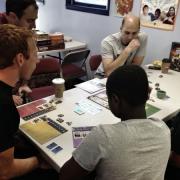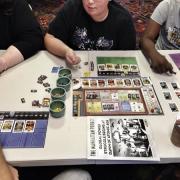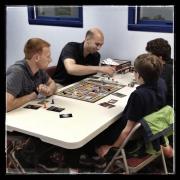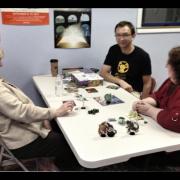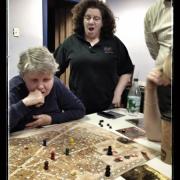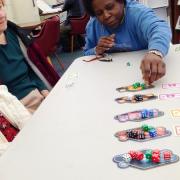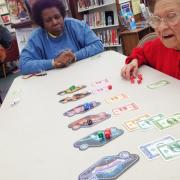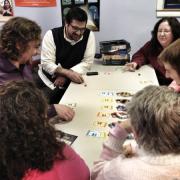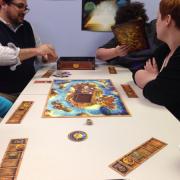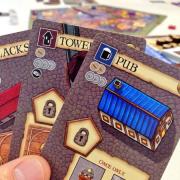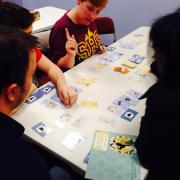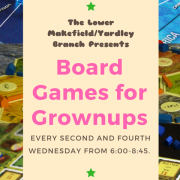Children
Tweens (10-12)
Teens
Young Adult
Adults
Intergenerational
Circulating Board Game Collection
$1,001-2,500
The Circulating Board Game Collection consists of 150 modern board games that circulate at each of our seven branches. The collection is expanded each year to include newly released games, more strategy games, and games for children. Each game is cataloged, and the components are bagged and inventoried.
We offer the games with rules in multiple languages to meet the needs of our growing immigrant community, and we also offer games with less text and more iconography for patrons will limited sight.
We find that, compared to mass-market and classic board games, modern board games offer a greater diversity of mechanisms, themes and content appropriate for family use and use in library programming, school instruction and community groups.
Advanced Planning
As part of its strategic plan, the Bucks County Library System (BCLS) strives to offer materials and programs that stimulate the imaginations of children and adults and provide pleasurable reading, viewing and listening experiences in current and emerging formats. In support of these goals, we created a pilot board game collection at one branch location, Bensalem.
Success was determined through two metrics: (1) circulation and (2) a survey to which a minimum of 90 percent of people responded that a board game supported or enhanced their creativity, and evaluated the experience as "very good" or "excellent." The planning team included the Bensalem Library manager, the Collection Management Office director and the collection management librarian.
Through the collection, we sought to:
- Lower the barrier of entry for new gamers. This means choosing games with simple rules; games with familiar mechanics used in interesting or novel ways; and games that could be taught and played quickly with minimal set-up.
- Expand community outreach centered on a positive and emerging cultural-building medium. This means the collection and related programming should focus on community and family-building first — gaming as a social activity.
- Encourage constructive play, social learning and friendly competition.
- Support learning and explore a diversity of games.
Ultimately, the Bensalem branch's starter collection included Forbidden Island, Ticket to Ride, Carcassonne, Splendor, Catan and Pandemic. We purchased the games through an online retailer with a good track record of supplying libraries and offering discounts (coolstuffinc.com). View a list of BCFL's game selection criteria under Attachments at right.
Items were purchased, processed and cataloged at the BCFL’s central Collection Management Office with the Bensalem Library manager providing metadata and cataloging subjects. Since there are no established venders for purchasing board and card games for libraries, we consulted with the manager to create guidelines and a collection management policy. Currently the Bucks County Collection Management Librarian Holly Ambrose and Library Manager John Pappas monitor the collection.
Most non-traditional collections have some challenges. Cataloging items according to game mechanisms and themes; training staff to promote, demonstrate and check in materials; and working on consistent displays across the library branches all created some difficulty in the beginning.
Marketing
We promoted the circulating collection through printed posters and digital displays at each branch. Items were displayed in high-traffic areas between the children’s/youth services and adult services areas of the library with box tops facing out. Dummy cases or bagged collections were used at first but were quickly abandoned.
I created a series of “alignment sheets” that briefly describe the game, player count, appropriate ages and length of play. (The “alignment” comes from the fact that I also “aligned” each game to Common Core standards for parents and schools.) These sheets are included in each copy of the game and also in a binder for staff to find suggestions for patrons. View posters and an alignment sheet under Attachements at right.
Budgeting
We spent $300 on the six game pilot collection for the Bensalem Branch. After the success of the pilot program, we expanded to all six branches with a budget of $1,500.
We budget $3,000 annually for new board games to be spread across the branches. Within that budget are incidental costs related to four corner bands to hold the box lids tight, small bags for components, and labels for inventory lists. To purchase the starting collection of six gateway games, the cost would be roughly $175 for the games and $25 for rubber bands and bags.
Day-of-event Activity
Along with the circulating board game collection, the library has promoted five different board game events: Board Games for Adults, Family Game Night, The Golden Gamers and The Game Designer Guild.
The Game Designer Guild and Board Games for Adults should be promoted on Meetup.com. We use a paid account for all the gaming events across the county, and it helps get fresh people to the events.
Board Games for Adults practically runs itself. We meet every other week, and staff selects one game from the collection to teach and demo for new players; other games from the collection are also on hand and available to play. Since we promote the events on Meetup, we tend to get experienced players who bring their own games and are willing to teach new players. Groups can be as small as four and as large as 30, but 10 to 15 is the ideal number. The goal of Board Games for Adults is to build agency within the group so they can begin to plan their own events, reserve the rooms, and teach the games without staff moderation.
Family Game Nights are the only events that feature mass-market games like Monopoly or Candyland. We set up several tables with mass-market and children’s games, along with family games for ages 8 and older. We use a drop-in model for Family Game Nights and have a couple volunteers help guide families to tables to get them started.
The Golden Gamers, a group for ages 65 and older, was promoted through senior living centers and our Senior Programming Committee. Once a month I would bring a selection of party and social games that could serve a large group and would attempt to teach one game to all the attendees. This was more hands-on than the Board Games for Adults group, and I usually required one or more volunteers to help teach the games. Games should be very simple with few rules. Card and dice games work well and can be played in 30 to 45 minutes. We offered the program for two years before moving on to other projects.
The Game Designer Guild started as a summer project but ended up lasting for a year. We hoped to attract gaming enthusiasts and game designers from our community to meet, play-test their games (or beta test games from large publishers), explore new games, and work together to design their own. We worked with a local game designer and an established guild to create a monthly gathering. Experienced designers would have new players to test their designs, and budding designers could learn from everyone how to design, test and hopefully publish their designs. We brought in established designers to speak, either remotely, or in person. Events generally lasted an entire Saturday afternoon and could be very time-intensive. They typically required a volunteer or staff person very knowledgeable in game design.
We've also recently started a Winter Board Games Night, where we visit local bars and cafes for an evening of board games, drinks and good times!
Program Execution
Board games are kept in the public area close to staffed service points. Materials are not kept behind the service desk, and dummy cases are not used. The original collection was kept in large, zippered canvas bags, but the collection was not able to stand out from the bagged toy collections and the adult book club bags.
Generally, patrons do not open the games in the library except when they are put out specifically for events (in which case they are checked out to “in-house use"). Items circulate for two weeks and have one renewal, so generally items are kept out for the full month (if popular) or returned within a day or so (if disliked or too complex). Once materials are returned, they are checked in and kept to the side for staff to check the contents. Patrons are not charged for missing pieces but can be charged for a replacement copy if not returned.
Patrons are overwhelmingly supportive of the collection. The more popular games have checked out 40 times over a two-year period (with an average of 32 checkouts for all of the games). In general, “gateway” games are the most popular; card games and children’s games are less popular.
Advice
Determine what you want the audience to experience from the board game collection. I split this into four categories:
- Experimentation/interaction: hobby and modern board games
- Comfort/familiarity: classic and mass-market games
- Competition/interaction: chess, bridge, Scrabble, mahjong, go
- Interaction: party and social games (games that encourage social interaction over strategic thinking, e.g. Whose Line Is It Anyway?)
Then determine the age or group you will focus on: children, families, teens/new adults, adults, seniors, all ages? Seniors may primarily want games that encourage comfort/familiarity and competition/interaction. Teens may want just competition/interaction. Families may want a little bit of everything. There is plenty of overlap here, but it is worth starting here to help focus the collection.
Start with games that are easy to learn, fast to set up and quick to play. Listen to patrons when they return the games; ask if they liked the game and which elements they enjoyed. (Which mechanisms were fun? Which themes were engaging?) This will help you expand the collection and add games that will add quality to your collection.
Supporting Materials
- Feedback (Coming Soon!)
- Programming Librarian Facebook Group

